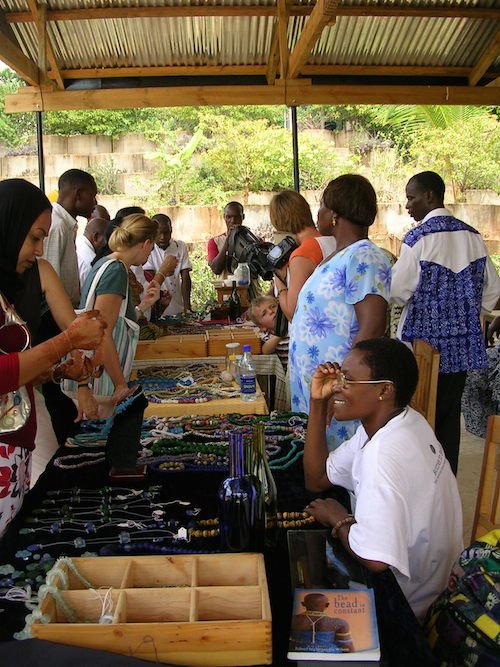Bottles to Beads
One self-help group in Dar es Salaam fashioned earrings and necklaces out of beads made from recycled glass. Alexandra Wilson, a British anthropologist who’d worked with the Krobo and Ashanti people in Ghana, knew about a low-technology method for using recycled glass to make beads. When she moved to Tanzania, Wilson facilitated a people-to-people transfer of technology from West Africa—where glass bead-making was an age-old custom—to east.
To implement her idea, she linked up with a Tanzanian resident who directed a project for street children in Dar. Sister Jean Pruitt helped Wilson coordinate the visit of Krobo bead makers from Ghana to Dar, and they set up a month-long workshop to teach their bead-making method to groups of disadvantaged Tanzanians.
Coming from an area that was hard-hit by the AIDS epidemic, the Krobo craftsmen agreed to share their knowledge and skills with other Africans in need without compensation.
Four bead makers from Ghana taught participants how to build a wood-fired clay oven and crush glass from recycled wine bottles. Together they made clay molds to hold the glass fragments and heat the beads until the glass fused. They poked holes in the beads and turned each one to shape them while they were still warm. Finally, they polished the beads on a grinding stone with sand and water before threading them into necklaces and earrings.
On the last day of the workshop they held a crafts sale attended by throngs of people keen to buy the colorful earrings and necklaces made from recycled glass bottles.
Another self-help group that got its start while I was living in Dar was Fair Trade Friends. Joy Stephens, who’d worked with Masai women in Tanzania in the 1990s, sought venues for the women to sell their intricate beaded jewelry. She formed a group that facilitated commerce between the Masai women and shops in Dar as well as in Arusha and Stone Town.
Fair Trade Friends grew into a cooperative that sold Masai women’s products in shops and paid the women in advance for their products. People were happy to buy the colorful jewelry with the added incentive of knowing that a fair portion of the money went directly to the women who made them.

